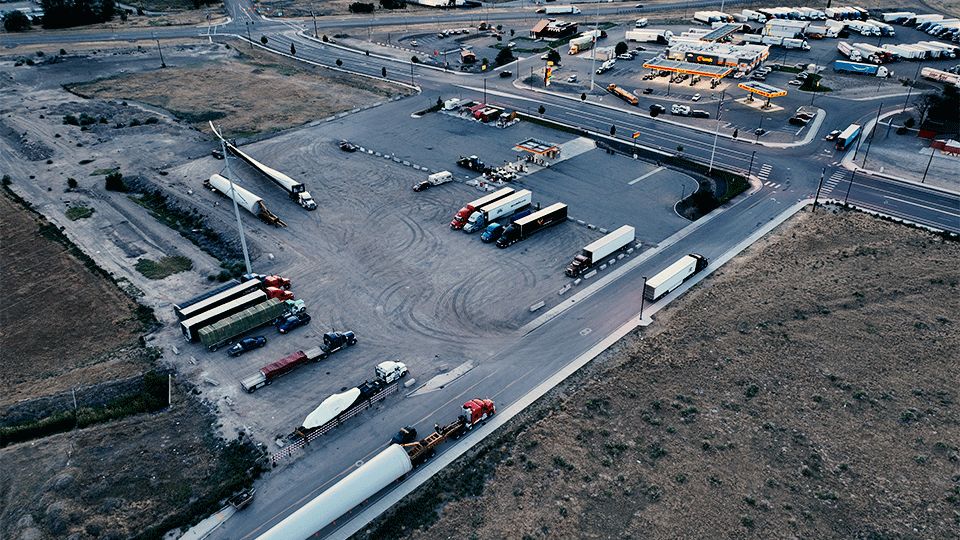
Your company moves freight. You’ve been at it for a long time. How long? One year? Five years? 10 years? More?
Either way, you’re familiar with paying freight rates. You probably have an allocated budget for shipping and shipping-related expenditures. The size of this budget was determined, in all likelihood, based on what you’ve spent in the past. That’s a good strategy.
However, if history is any indicator, freight rates will continue to be unpredictable.
In the end, your budget serves more as a rough estimate, a baseline, than anything else. But, who knows, maybe it’s more than you’ll need.
Understanding freight rates — the factors influencing them, what drives them up, what drives them down, etc. — is a fundamental skill for people in your position. With so many factors at play and so much variance in their impact over time, accounting for them all can be difficult.
Here at Anderson Trucking Service (ATS), we have articles addressing many of the factors that drive freight quotes. You can find all of them here.
Those articles, although certainly worth reading, don’t address — in any major way — one of the most significant aspects of pricing a shipment: load-to-truck ratio.
The current load-to-truck ratios at your cargo’s origin and destination locations play a major role in determining the price of securing coverage to and from them.
Below, you’ll find an outline of everything you need to understand about load-to-truck ratios including:
- What load-to-truck-ratios are
- How often area load-to-truck ratios change
- How transportation companies use load-to-truck ratios to formulate pricing
- Which locations, historically, have higher load-to-truck ratios
- Which locations, historically have lower load-to-truck ratios
- What impact load volumes have on your rates
- Where you can find load-to-truck data to help you plan better going forward
Rounding out your understanding of transportation pricing can’t be done without a knowledge of load-to-truck ratios. And, planning according to the trends (quarterly, seasonally, etc.) that emerge in your destination/origin locations will make managing your transportation dollars a bit easier.
What is a Load-To-Truck Ratio?
Typically presented as a single number, a load-to-truck ratio is the calculation of two data points: the total number of loads (freight to be shipped) in an area and the total number of trucks able to haul a load in that same area. The load-to-truck ratio of a city/state/region is measured by dividing the total loads by the number of available trucks.
For example, on any given day, Montana may have 300 outbound loads available and 100 trucks to haul them. This would be a 3:1 load-to-truck ratio or ‘+3’ on a demand/capacity scale.
Essentially, these ratios measure the balance between supply and demand in an area. With this data, transportation providers can make pricing discernments, weighing the outbound opportunity when sending trucks in and the opportunity cost of moving a driver away from an area of high load volume.
It’s also important to note that load-to-truck ratios can be broken down by trailer type, with an area’s dry van load-to-truck numbers differing from its flatbed and reefer data.
What is Considered a Good Load To Truck Ratio?
There is not a single answer to the question “what is a good load-to-truck ratio?” This depends on your transportation company’s network strengths and the needs of your business.
However, at a high level, a ratio of two loads for every truck is considered healthy. By and large, sending freight to an area with a 2:1 ratio (or more) will positively influence your rates — carriers know they will (in all likelihood) get another load to move.
That said, as a location’s ratio falls — to an even 1:1 or into a load-truck deficit — it begins to be considered “tight” or “cold” for freight movement — affecting the price of shipping to/from it. A location with a 1:2 load-to-truck ratio, for example, would be a bad (expensive) location to ship to.
How Often Do Load-To-Truck Ratios Change?
Load-to-truck data points change every day. That said, the elasticity of these numbers will depend on the scale of reference. To help you understand what I mean, let’s break this down by how these ratios may change, over the course of a few months, nationally, regionally and within a city:
Nationally
Nationally, the load-to-truck ratio in the U.S. adjusts marginally from month to month — from +3.46 in June to +3.87 in July (for example). On a macro level, the total load and truck count in our nation does not change substantially over such a short period.
For this reason, it’s not uncommon to see minute fluctuations on a national scale over the course of time.
Drill a bit deeper, get more targeted, and you’ll uncover a different story. . .
Regionally
Load-to-truck ratios in a specific region, like the Midwest, change more rapidly.
Usually, chunks of our nation see their load and truck counts undergo more pronounced swings than we see across the U.S. as a whole. Often, these changes are brought on by seasonal changes. In the northwest, for example, Christmas tree season brings a lot of trucks to Oregon and Washington as the number of available loads increases.
 Produce harvest in southern states is another example of this. In the mid to late Spring, large numbers of dry van and reefer truck drivers head into southeastern states to begin hauling fresh produce. As a result, the load-to-truck ratios tend to spike when thousands of loads need to be hauled.
Produce harvest in southern states is another example of this. In the mid to late Spring, large numbers of dry van and reefer truck drivers head into southeastern states to begin hauling fresh produce. As a result, the load-to-truck ratios tend to spike when thousands of loads need to be hauled.
Within a City

With so much freight moved by truck, it is not unusual for load-to-truck numbers to change significantly in a city over the course of a month. Cities like Atlanta, Detroit and Houston, have tons of outbound freight requirements, sending truck drivers in and out with regularity.
As a result, these locations may hold anywhere from 3:1 upwards to 14:1 ratios depending on how well these outbound demands are predicted and planned for by carriers with assets in the area.
How Do Transportation Companies Use Load-To-Truck Ratios to Formulate Pricing?
How the quantity of available loads stacks up to the number of trucks in your pickup and drop locations can greatly influence your rates. Primarily, these numbers tell your transportation company two things:
1) How likely it is that they will find their next load at, or near, your drop location
Although it’s not the only thing impacting a carrier’s ability to find their next load, your destination’s load-to-truck ratio plays a role. This number communicates the level of competition in the area where their truck will arrive. And, since trucking companies are essentially rental companies (only making money when their assets are in use) promptly securing their next load is imperative.
The last thing a carrier wants is to end up in a location with a “tight” load-to-truck ratio, making it more difficult to keep that driver moving efficiently. This will increase your price.
On the other hand, if your destination has far more loads than it does trucks, expect your price to decrease. Knowing that their asset will remain productive after completing your load is the goal of every trucking company. This knowledge will allow them to price your freight more competitively.
2) Their level of bargaining power (and the cost of transportation service) in your pickup location.
For every shipment, there are two load-to-truck ratios to consider. On the origin side of this equation, a carrier uses this ratio to weigh their options and gauge their price.
Trucking companies only have a finite number of assets (trucks, trailers, drivers and equipment). As such, they’re motivated to get as much production as possible out of them.
For this reason, expect your outbound freight rate to reflect the level of supply (trucks) and demand (loads) in your area. Should your origin have a 1:2 load-to-truck ratio, expect your price to fall as drivers scramble to secure a shipment away from such a tight market.
On the flipside, shipping from a demand-rich origin — like the south during harvest season — will drive your rates up. Your freight is competing against plenty of other freight, increasing the price of securing limited coverage.

Which Locations Typically Have Higher Load-To-Truck Ratios?
It is difficult to generalize at this moment which locations will have the highest load-to-truck ratio next month, next week or even tomorrow.
However, we can pinpoint a few characteristics of the areas that consistently boast higher load-to-truck ratios.
Among others, you’ll commonly see load-to-truck ratios higher in:
- Areas near international ports
- Areas with high outbound freight demands
- Manufacturing hubs, locations with a lot of unfinished goods
- Locations subject to seasonal fluctuations during their peak time of the year
- Christmas trees in the northeast, produce in the south, construction projects in northern states, retail goods in large cities, etc.
Freight shipping “hot” zones shift, somewhat predictably throughout the calendar year. Planning for these changes can help you get ahead of things as you’re scheduling out your own loads.
Related: How Does Your Freight’s Origin Impact Your Final Shipping Price?
Which Locations Usually Have Lower Load-To-Truck Ratios?
Here again, it is difficult to list exact areas where load-to-truck ratios are lower as this can change at any given time.
For the most part, however, places that have fewer outbound shipments and inbound freight will have a lower ratio as a result.
Some characteristics of these locations are:
- Remote, off the beaten path and/or hard to reach
- Mountainous regions (particularly in winter), overly congested areas (like the island of New York City)
- Little or no freight coming in and less going out
- Locations with tourism-based economies like Florida and Las Vegas
- Small towns and states with lower populations
Each of these locations is difficult for trucking companies to service — especially when sending freight in. As a result, there are usually fewer trucks in these locations to mirror the low freight volume.
Related: The Top 5 Most Expensive Freight Shipping Destination Types
The Impact Load Volumes Have On Your Rates
Load-to-truck ratios are the foundation of freight shipping prices. That said, just because your destination has a solid ratio doesn’t mean you’ll pay a relaxed rate.
Freight volume also plays a role here. In fact, a location with 2,000 loads and 1,000 trucks (2:1) can sometimes be cheaper to ship to than a location with 200 loads and 50 trucks (4:1).
The reason for this is simple: your carrier’s market opportunity (potential to get a load) is greater in areas of high freight volume, even if there are more trucks there.
The greater the pool of loads, the better chance your carrier has to secure its next “right fit” shipment in a timely manner. Commonly your provider has ongoing relationships with customers in these high-volume areas, decreasing the difficulty of shipping to them.
So, when thinking about how load-to-truck ratios impact your freight rates, volume is also important to consider.
If you’ve ever run into a situation where — everything else the same — sending “commodity A” 800 miles to a destination with 1,000 loads and a 1.5:1 ratio costs less than sending a shipment of the same product to a location with 50 loads and a 4:1 ratio, guaranteed volume opportunity is the reason.

Where Can You Find Load-To-Truck Ratio Data?
Obviously, this data is an important factor in the freight rates your providers offer you. Running a trucking company, and remaining profitable is a challenging endeavor that takes proper management, historical data analysis and robust upfront planning. Load-to-truck ratios are a major tool for every transportation provider.
As such, you’re likely wondering whether you can access this information as well.
Utilizing these data points is a great way to prepare your business for the intricacies of the transportation world. Luckily, there are several ways for you to access and review historical and up-to-date load-truck data.
DAT Freight & Analytics offers a free weekly snapshot of freight movement and volume data. Here you can look at dry van, flatbed and reefer load-to-truck ratios across the nation right now. DAT also offers a robust market conditions map for shippers and transportation companies to reference.
Additionally, there are several paid services that provide in-depth reporting that you can utilize. Most namely, Freight Waves Sonar is an excellent tool.
Your Next Step Toward Mastering Your Budget
Now that you have an understanding of the profound role local/area load-to-truck ratios at your pickup and drop locations impact your freight rates, I hope you’re more comfortable with how your rates are calculated.
The next rate-specific topic you’ll want to wrap your head around is how a truck driver’s total time on your load, impacts the kind of pricing you receive. In some situations, a 400-mile length of haul can cost more than a shipment going 600 miles.
To avoid overpaying for your next shipment, you’ll want to understand why.
So, check out this article on the differences and use-cases of rate-per-mile vs. daily rate pricing for an overview of this information.
Finally, if you have any questions about what you should expect your next shipment to cost, visit our Pricing Page now.




